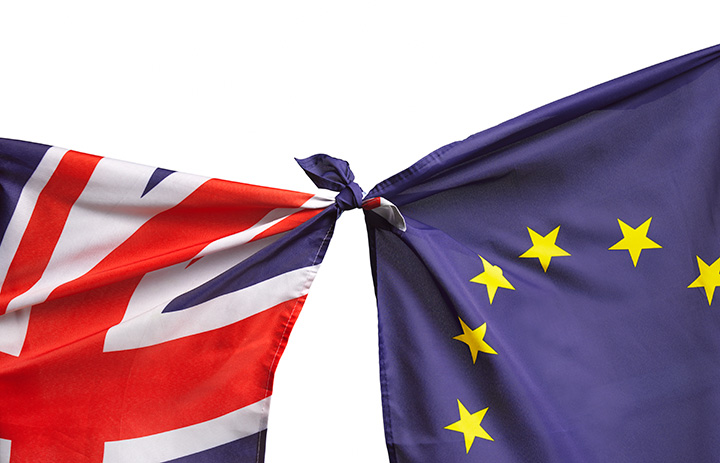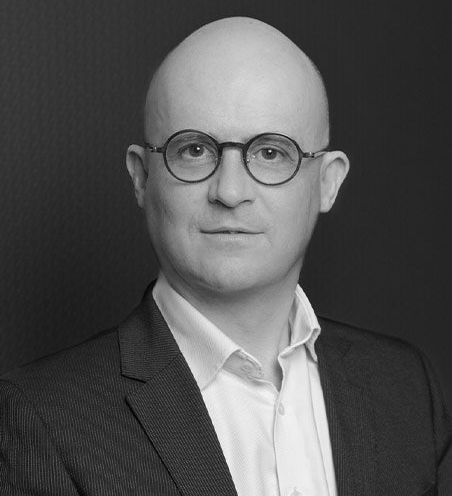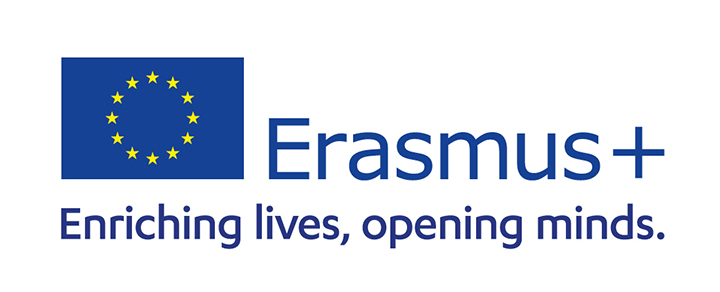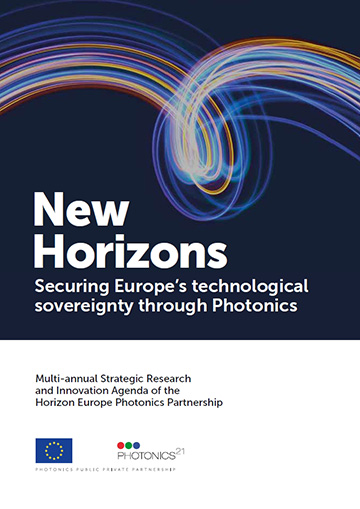
[Image: P. Dazeley/Getty Images]
On 24 December 2020—almost literally at the last minute, and more than four years after the United Kingdom voted to leave the European Union—the U.K. and the EU finally sealed a trade and cooperation agreement to govern their post-Brexit relationship. The agreement’s stakes were high; in 2019, some 43% of Britain’s exports of goods and services went to the EU.
For a while, the final months of negotiation on a new framework to govern that big chunk of trade seemed impossibly snagged on arcane details of fishing rights in U.K. waters and state aid to industries. In the end, though, the December accord—which guarantees tariff-free trade in most goods between the U.K. and the EU—led to deep breaths and a sense of relief on both sides of the Channel.
The immediate aftermath of the agreement, which came into force 1 January 2021, included some well-reported delays and snarl-ups for imports and exports of trade goods, as businesses attempted to grapple with a suddenly “hard” U.K.–EU border and new paperwork requirements. But now, three months in, much of that dust has settled. To get some insight on the accord’s impact for photonics—and, particularly, on the U.K.’s future participation in the new framework program for EU research funding, Horizon Europe—OPN recently talked with several members of the European photonics community.
Politics and reality
Notwithstanding the eleventh-hour post-Brexit agreement in December 2020, one could be forgiven for thinking that relations between the U.K. and the EU have reached something of a low point in the past several months. Tensions have especially flared over the availability of COVID-19 vaccines, and over the complex post-Brexit status of Northern Ireland. There was even an announcement, in February, that a Cold War-style “emergency hotline” would be set up between Brussels and London to handle post-Brexit tensions.
Yet in the wake of the December agreement, these political twists and turns might prove relatively unimportant to the real-world photonics business.

James Regan. [Image: Courtesy of J. Regan/Effect Photonics]
“I think it’s important to pick apart government posturing from teams of people actually working on the ground,” says James Regan, the CEO of the Eindhoven, Netherlands–based company Effect Photonics, which develops and manufactures on-chip modules for the communications market. “Our governments do what our governments do, but where there are long-standing relationships, those are largely not affected by that … Business is done between people, not between governments.”
A sense of relief
Regan is particularly well positioned to see both sides of the post-Brexit agreement. While headquartered in Eindhoven, Effect Photonics also operates a development lab and manufacturing facility in Brixham, Devon, U.K. (The company has a unit in Taiwan as well, and Regan expects that it will branch into other world regions in the future.) From that broad perspective, he says that one of the biggest benefits of the deal is simply putting an end to more than four years of uncertainty since the 2016 Brexit vote.
“It was very frustrating,” Regan observes. “Like all of business, what we wanted was to have clarity … Nobody likes the inability to plan.” Another frustration, he adds, was that “people will often tend to assume the worst-case scenarios,” an orientation that Regan believes can distract from important issues. “At least now we have clarity,” he says. “We understand what the situation is, and we go forward and build around the landscape that we find.”
John Lincoln, the head of the U.K. Photonics Leadership Group, which provides information and advocacy for country’s photonics industry, likewise views “the removal of complete uncertainty” as the biggest impact of the post-Brexit agreement. He says that the ongoing uncertainty had led to “a distinct tailing off” in the past four years for U.K. participation in Europe-wide research consortia and in pan-European groups like Photonics21.

John Lincoln. [Image: Courtesy of J. Lincoln]
The ebbing of participation in the research consortia was a particular disadvantage, according to Lincoln. “Being in one program tends to lead into being in the next program” for a research group, he points out. “That chain has been broken by this four years of uncertainty, which means it’s no longer obvious to have a U.K. partner in.”
Return to collaboration
For this reason, one of the biggest pieces of good news from the December agreement—for scientists on both sides of the Channel—was that the U.K., in exchange for a €2 billion (US$2.36 billion) annual contribution to the program, would be able to participate as an associated country in the EU’s new Horizon Europe funding framework program. That framework will provide some €95.5 billion in R&D funding for EU member states and associates between 2021 and 2027.
Lincoln admits, however, that it will “require work from the U.K. side to get back in,” given the erosion of some bonds during four years of Brexit, plus the extra blow of COVID-19. “We need to reach out, re-engage with those networks, re-engage with people in consortia—people we might once have been speaking with once every few weeks, who now we haven’t spoken with in six months,” he says. “It requires rebuilding momentum.”
James Regan likewise feels that—in addition to the removal of uncertainty, and the fact that the deal does not involve tariffs between the EU and the U.K.—the re-integration of the U.K. into EU collaborative research is a big plus. “Over here in Europe, these European collaborative projects have always been kind of the mainstay of building partnerships and consortiums allowing different universities and companies to collaborate,” he says. “I think the fact that the U.K. will continue to participate in these collaborative projects is very important for my friends at universities.”
Horizon Europe’s future
With the European Council having given its blessing to the proposed rules and structure for Horizon Europe, the program is set for final approval and adoption by the European Parliament in April 2021. At that point, the European Commission will start publishing final work programs determining how money in the first few years will actually be spent. And in both the EU and the U.K., photonics researchers may find competing for those money pots a bit more challenging than in the past.

Roberta Ramponi. [Image: Courtesy of R. Ramponi]
Photonics enjoyed a privileged position in the immediate predecessor to Horizon Europe, the highly successful Horizon 2020 framework program that governed EU R&D spending from 2014 to 2020. In Horizon 2020, photonics was identified as one of six Key Enabling Technologies (KETs) tapped for special support and funding. But Roberta Ramponi, the director of CNR-IFN and a professor of physics at Politecnico di Milano, Italy, as well as an executive board member of Photonics21, says that under Horizon Europe, photonics has “again been somehow merged with microelectronics” from the point of view of the EC.
In some respects, Ramponi admits, this makes sense given that the two technologies often support each other. “But the ecosystems, in terms of industries, are completely different,” with microelectronics dominated by very large companies and photonics predominantly consisting of small- and medium-sized enterprises (SMEs). The latter, she maintains, “need targeted programs that are much more flexible than those needed by microelectronics.”
On a positive note, the status of the photonics public-private partnership (PPP), established under the aegis of Photonics21 during Horizon 2020, will be maintained in Horizon Europe—and that, Ramponi says, “gives us some independence and control on the roadmap.” But funding dedicated specifically to photonics in Horizon Europe, at least as currently constituted, could be as much as 30% less than in Horizon 2020.
Mission and applications driven
The 30% decline in photonics funding is, in one sense, more apparent than real, relating to changes in the structure and goals of Horizon Europe. In particular, the program now places much more of its funding weight than past framework programs on application-led “grand challenges” and mission-driven funding in areas such as climate, health, and “digital sovereignty.” In principle, photonics, as a key enabling technology, will find a place in Horizon Europe funding for many different application areas under such a scheme.
The updated industry roadmap document published by Photonics21 in December 2020 put a heavy stress on photonics’ role in enabling newly framed EU priorities such as climate, health and digital sovereignty. [Image: Photonics21]
In practice, though, Ramponi observes that this spreads the field rather thin, and threatens development that targets basic technology. “It dilutes the funding much more,” she maintains, “and makes it more difficult for the photonics industry to have a roadmap with sufficient co-funding from Europe … It risks making the field a bit less organized.”
Ramponi recognizes that, from the point of view of the EC, “you need to target the final step of the application”—especially in light of the coronavirus pandemic, which has demonstrated the value of targeted initiatives to solve a specific societal problem. “But if you don’t support the technology, in a few years you will no longer be able to target the final step of the application.”
John Lincoln agrees that the shift of the EC funding focus away from photonics as a KET, and toward grand challenges, will complicate things a bit. “The challenge-led agenda is politically expedient, because it lets them say, We’re funding this challenge to society and that challenge and that challenge, and we’ll pool enabling technologies to provide solutions,” he says. But it makes it difficult to explain the impact of photonics technologies to a more diffuse, less expert set of stakeholders, and to figure out the best places to put one’s efforts to snag new funding. The result may require what Lincoln calls “a broader collaborative approach in the photonics community” for identifying potential opportunities in the vastness of the wider Horizon Europe program.
Lincoln believes that the complexities of Horizon Europe’s societal-challenge funding focus are actually another good reason for EU scientists and U.K. scientists to re-engage and work together after Brexit. In the U.K., he says, “we’ve been living under challenge-led industrial funding for more than a decade … It’s something we’re very, very used to.” And that experience, he suggests, could prove helpful to European scientists trying to navigate this new EU funding landscape.
EIC and Erasmus
While the U.K.’s participation in Horizon Europe (as well as a number of other big EU science and technology efforts such as Euratom and the European space program) is good news, there are a few notable areas under the post-Brexit accord in which the U.K. will not be participating.
For example, while the U.K. will participate in the European Innovation Council as it did during Horizon 2020, it won’t be eligible for loans or equity investments by the new European Innovation Council (EIC) Fund, which will dole out some €3 billion in accelerator financing to “scale up innovative start-ups and small and medium-sized businesses.” The U.K.’s exclusion from the EIC Fund likely reflects both the EC’s desire not to fund potential competitors to EU companies, and the U.K.’s desire to chart its own course on translational innovation. U.K. entities can still apply for non-equity grants from the EIC accelerator program, however. And they can also participate “on an equal footing,” according to EC documents, in the EIC Pathfinder component, which provides €3–€4 million grants to “support early stage development of future technologies.”

[Image: European Commission]
The U.K. also won’t be participating in the Erasmus+ education program, which will devote €26.2 billion for projects in “mobility and cooperation” across European countries from 2021 to 2027. Lincoln—who says he was one of the original Erasmus exchange students back in the 1980s—thinks the U.K.’s lack of participation in Erasmus+ is “a real shame.” The program “helps early mobility of people right at the beginning of their careers,” he notes, “and that early mobility builds relationships and friends across Europe.” (With the loss of Erasmus participation, the U.K. is creating its own exchange program, the Turing Scheme, to provide study-abroad opportunities for students there.)
From near-term chaos to long-term partnership?
To be sure, the inking of the post-Brexit agreement in December brought some near-term headaches in January, as companies accustomed to friction-free transport of goods across borders suddenly faced new paperwork and bureaucratic hurdles.
“In the immediate aftermath of the implementation, we saw a lot of chaos in the logistics of moving goods around,” says James Regan of Effect Photonics. But, he adds, “we’re already seeing that that has been dying away quite rapidly … You learn to do the paperwork, and then it almost disappears as an issue.” And, says John Lincoln, “photonics goods don’t need to move as quickly as fresh food … 24 hour delivery isn’t normally essential.”
Lincoln adds that it’s “very hard to separate” these impacts of Brexit from the impact of COVID-19—“almost impossible, in fact.” And some of the communications technologies that have eased other aspects of the pandemic have been useful in the photonics business as well. “You now see people doing remote installation” of equipment via Zoom or other channels, he notes. “That was previously unheard-of.”
Indeed, the pandemic will likely remain a far bigger preoccupation for both the U.K. and the EU than Brexit in the near term. Roberta Ramponi observes, for example, that there is still much uncertainty about how the massive EU pandemic recovery funding will actually be spent, and on the split between investing in future activities and assisting those most harmed by the pandemic today.
Looking at the long term, however, James Regan stresses the strong bonds that continue to link Britain and the continent.
“I think it’s very important to understand that, with Brexit, the U.K. didn’t leave Europe,” he says. “The U.K. just left a particular financial organization … Speaking as the CEO of Effect Photonics, I’m glad that our U.K. team will contribute to continue to contribute alongside our Dutch team.”
[Update, 30 March 2021, 16:15 EDT]: This story has been updated to clarify the U.K.’s participation under the European Innovation Council.

